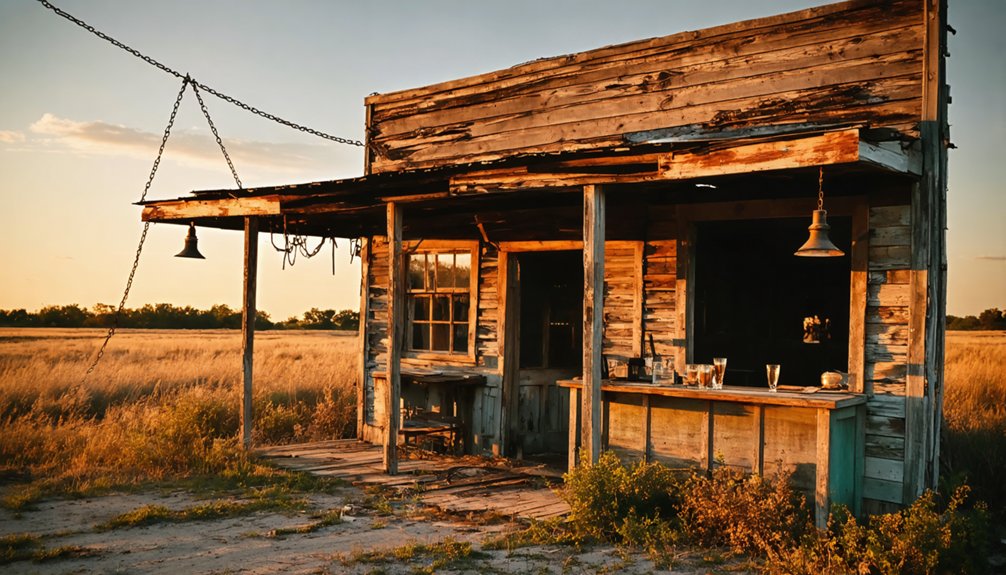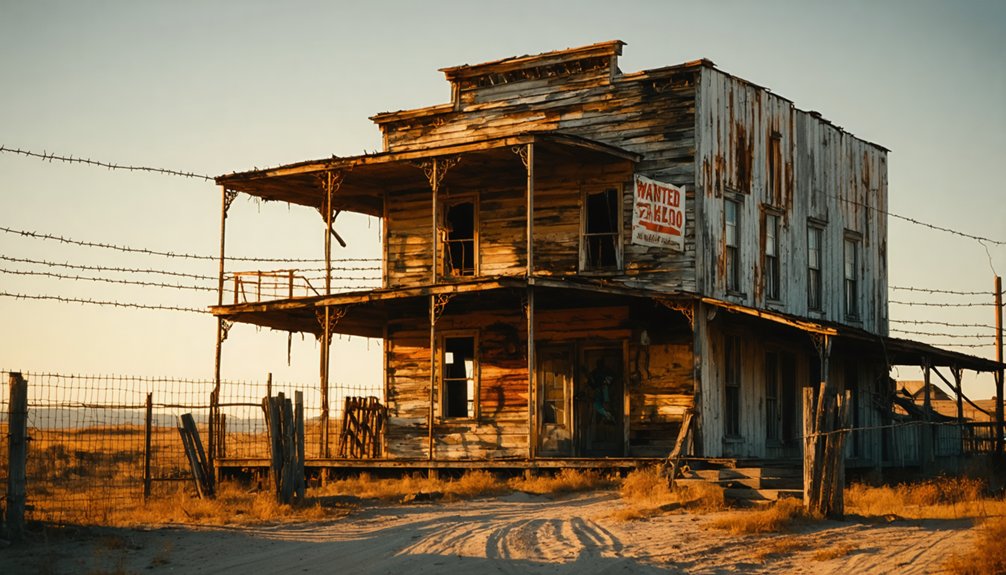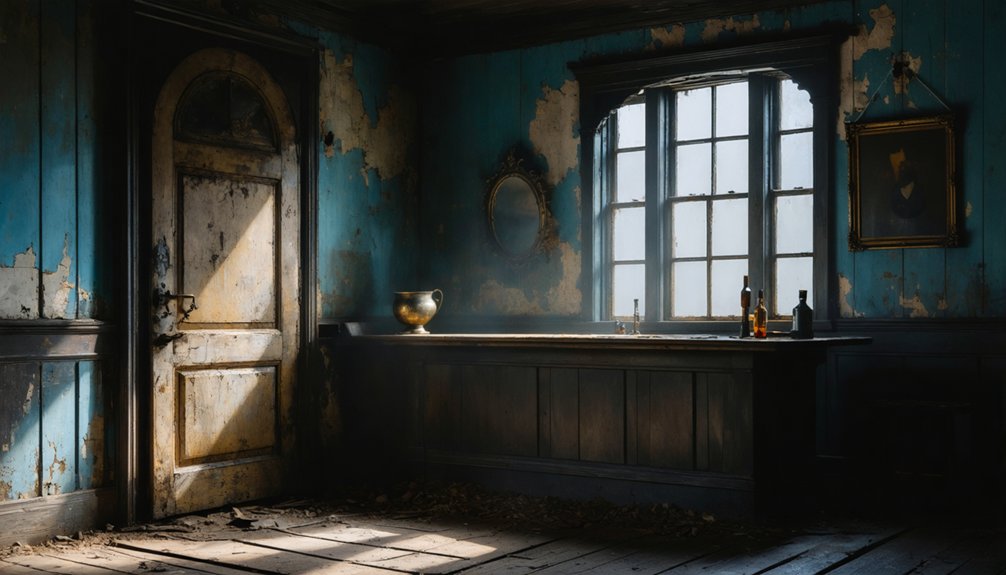When exploring South Dakota’s ghost towns, do thorough research on historical significance and property ownership status to avoid trespassing. Pack essential safety gear including GPS, maps, water, and emergency supplies—remote locations can present unexpected challenges. Document your discoveries respectfully by staying on established paths and never removing artifacts or entering unstable structures. These abandoned settlements offer profound connections to frontier history for those who approach them with proper preparation and reverence.
Key Takeaways
- Always research property ownership status before visiting to avoid trespassing on private land.
- Pack navigation tools including GPS devices, physical maps, and compasses when exploring remote locations.
- Wear sturdy waterproof boots and weather-appropriate clothing suited for unpredictable conditions.
- Bring emergency supplies including first aid kit, water, snacks, and communication devices.
- Document findings respectfully without disturbing artifacts or entering unsafe structures.
Research Your Destinations for Historical Context and Access
Before initiating your South Dakota ghost town expedition, thorough research proves essential for both historical understanding and practical logistics. Consult South Dakota State University’s database of 245 documented ghost towns, which provides vital details about settlement patterns, abandonment causes, and geographical distribution.
Effective exploration techniques require verifying property ownership status, as many sites lie on private land necessitating permission. Check county offices for current land records to avoid trespassing issues.
Understanding seasonal accessibility challenges will prevent travel complications, especially for remote locations.
Investigate each site’s historical significance within broader economic contexts—whether tied to gold mining, fur trading, or railroad development. The Black Hills region alone contains over six hundred ghost towns ranging from intact structures to barely visible foundations. This contextual knowledge enhances your appreciation of physical remnants like mine shafts or building foundations, transforming a simple visit into a meaningful connection with South Dakota’s frontier past.
Consider visiting specific locations like Kappa Ghost Town, which offers historical significance tied to railroads and natural springs that make it an excellent destination for photography and exploration.
Pack Essential Gear for Remote Ghost Town Adventures
Proper preparation forms the cornerstone of any successful ghost town expedition across South Dakota’s remote landscapes. Your gear checklist should prioritize safety and adaptability in these isolated environments.
Start with clothing selection suited for South Dakota’s variable climate—durable, weather-appropriate layers and sturdy waterproof hiking boots with ankle support.
Pack navigation essentials including GPS devices, physical maps, and compass, as cell service is nonexistent in many abandoned settlements.
Don’t underestimate the importance of emergency supplies: first aid kit, sufficient water, high-energy snacks, whistle, and multi-tool.
For documentation, secure cameras in protective cases and consider drones for safely viewing inaccessible structures.
Always carry a portable charger, inform someone of your itinerary, and bring bright or reflective clothing to enhance visibility when exploring these fascinating yet potentially hazardous historical sites.
When visiting towns like Ardmore, be aware that many structures contain acidic water that remains unsafe for consumption or contact.
Remember to always visit during daylight to maximize visibility and safety when navigating through deteriorating buildings and overgrown terrain.
Document Your Findings While Respecting Historical Sites
Carefully documenting your discoveries at South Dakota’s ghost towns isn’t just about collecting memories—it’s about contributing to historical preservation while minimizing your impact on these fragile sites.
Capture the past through thorough photographic documentation using high-quality cameras, while recording precise GPS coordinates of structures and artifacts. Before visiting, gather historical maps and archives to compare with present conditions. Always remain on established paths, refrain from moving artifacts, and never enter unsafe structures without permission.
Ethical considerations should guide your work: obtain necessary permissions before publishing findings, collaborate with local historical societies, and avoid sharing sensitive locations that might attract vandalism.
Organize your data systematically and consider contributing your records to public archives—transforming your exploration into valuable historical research that respects these silent testimonies to South Dakota’s frontier past. Your documentation methods can follow the approach used in academic studies that identified 245 abandoned settlements across South Dakota. Notable towns like Hooker and Emmet showcase the unique character and historical significance that make these abandoned places worth preserving.
Frequently Asked Questions
Which Ghost Towns Are Suitable for Children to Explore?
Ardmore, Rockerville, Spokane, Okaton, and Cottonwood offer family-friendly activities for your children. These kid-friendly ghost towns feature maintained structures, easy access, and educational value without significant hazards.
Are There Guided Tours Available for South Dakota Ghost Towns?
You’ll find numerous guided ghost tours throughout South Dakota, especially in the Black Hills. These expeditions reveal the historical significance of abandoned settlements through expert narration and carefully planned routes.
What Is the Best Season to Visit Ghost Towns?
Late spring (early June) offers ideal conditions for your ghost town explorations, balancing comfortable temperatures with minimal crowds. Fall visits provide vibrant foliage, while winter experiences deliver solitary atmospheres but require weather preparedness.
Can I Metal Detect or Collect Artifacts at Ghost Towns?
Legally restricted but possible, metal detecting requires proper permits and permission. You’ll need to follow strict artifact preservation guidelines, fill holes, and report significant finds. Many ghost towns prohibit collecting entirely.
How Dangerous Are Abandoned Mine Shafts in These Areas?
Abandoned mine shafts pose extreme dangers, including falls exceeding 50 feet, sudden collapses, and exposure to toxic contaminants. You’ll face significant shaft hazards where mine safety measures are absent or deteriorated.
References
- https://en.wikipedia.org/wiki/List_of_ghost_towns_in_South_Dakota
- https://core.ac.uk/download/pdf/345016075.pdf
- https://kids.kiddle.co/List_of_ghost_towns_in_South_Dakota
- https://www.ndstudies.gov/sites/default/files/LessonPlans/LessonPlan-HighSchool-GhostTownsOfNorthDakota.pdf
- https://www.youtube.com/watch?v=_0WNYsFLSLA
- https://www.youtube.com/watch?v=GQH5mp2emBw
- https://www.powderhouselodge.com/black-hills-attractions/fun-attractions/ghost-towns-of-western-south-dakota/
- https://www.youtube.com/watch?v=De3wGn9KDkg
- https://kxrb.com/the-creepiest-ghost-towns-in-all-of-south-dakota/
- https://baselocal.com/sd/a/best-ghost-towns-in-south-dakota-maps-access-safety-tips/



